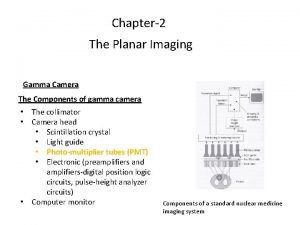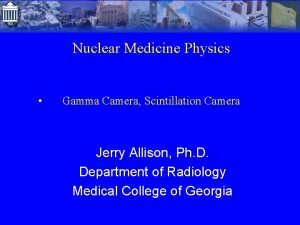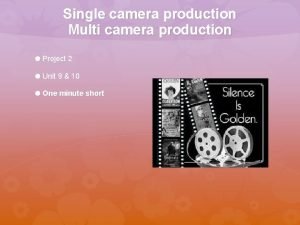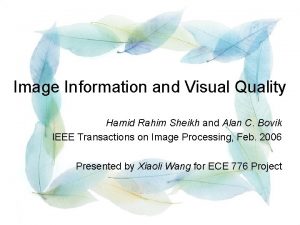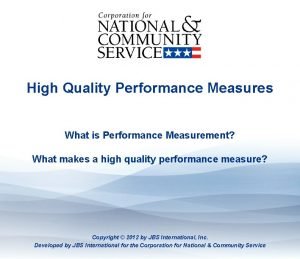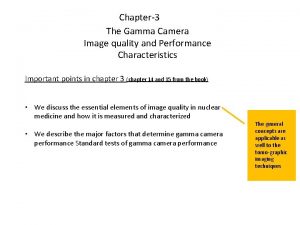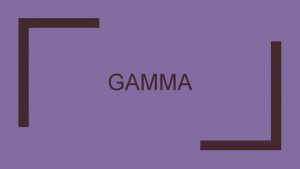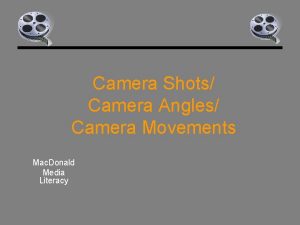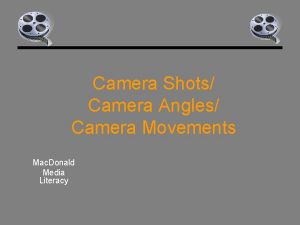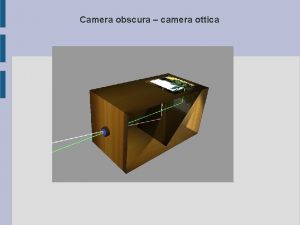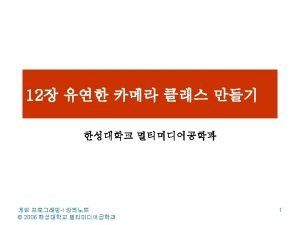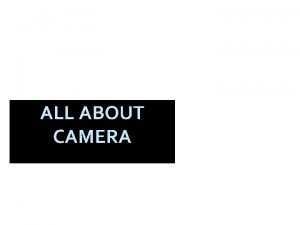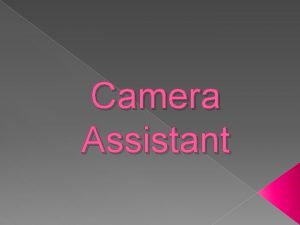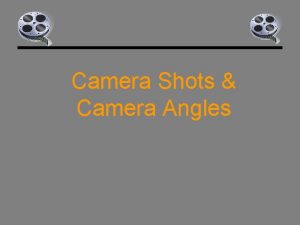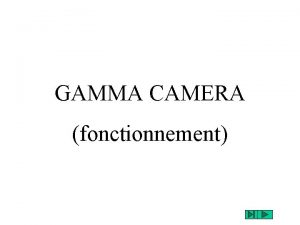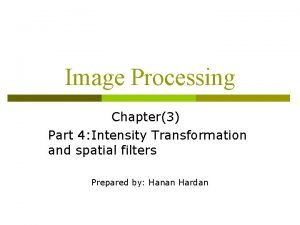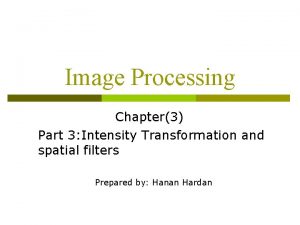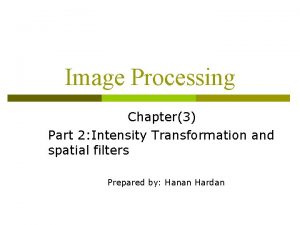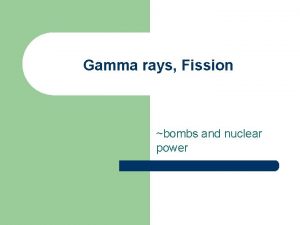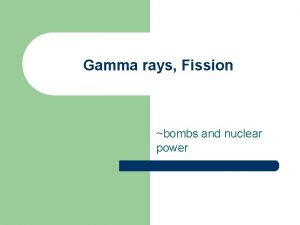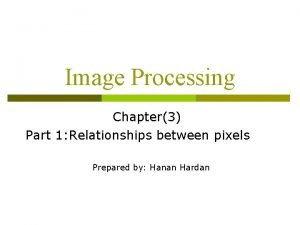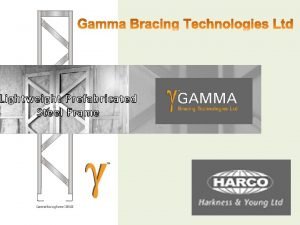Chapter3 The Gamma Camera Image quality and Performance

































- Slides: 33

Chapter-3 The Gamma Camera Image quality and Performance Characteristics Basic Methods for characterizing and evaluating image quality The first by means of physical characteristics that can be quantitatively measured or calculated for the image and image system • • Spatial resolution Contrast Noise Contrast-to-noise ratio (CNR) The second by means of observer performance studies using images obtained with different imaging systems or under different imaging conditions

Chapter-3 The Gamma Camera Image quality and Performance Characteristics Evaluating image quality using physical characteristics 2. Contrast • Image contrast refers to differences in intensity in parts of the image corresponding to different levels of radioactive uptake in the patient. • A general definition of contrast is that it is the ratio of signal change of an object of interest, such as lesion, relative to the signal level in surrounding parts of the image.

Chapter-3 The Gamma Camera Image quality and Performance Characteristics Evaluating image quality using physical characteristics 2. Contrast • In nuclear medicine, a major component of image contrast is determined by the properties of the radiopharmaceutical. It is desirable to use an agent having the highest lesion-to-background uptake or concentration ratio. • The major factor affects contrast is added background counting rates that are superimposed more or less uniformly over the activity distribution of interest.

Chapter-3 The Gamma Camera Image quality and Performance Characteristics Evaluating image quality using physical characteristics 2. Contrast • Background counting rates can arise from a number of sources: • Septal penetration is avoided by using a collimator that is appropriately designed for the radionuclide of interest • Inadequately shielded radiation sources elsewhere in the image environment • Scattered radiation scattered radiation can be minimized by pulse-height analysis, however, the system cannot reject all scatter ? ?

Chapter-3 The Gamma Camera Image quality and Performance Characteristics Evaluating image quality using physical characteristics 2. Contrast • Background counting rates can arise from a number of sources:

Chapter-3 The Gamma Camera Image quality and Performance Characteristics Evaluating image quality using physical characteristics 2. Contrast • Background counting rates can arise from a number of sources:

Chapter-3 The Gamma Camera Image quality and Performance Characteristics Evaluating image quality using physical characteristics 2. Contrast • Background counting rates can arise from a number of sources:

Chapter-3 The Gamma Camera Image quality and Performance Characteristics Evaluating image quality using physical characteristics 2. Contrast • Background counting rates can arise from a number of sources:

Chapter-3 The Gamma Camera Image quality and Performance Characteristics Evaluating image quality using physical characteristics 2. Contrast • Background counting rates can arise from a number of sources: • An important contributor to background radiation in conventional planar imaging is radioactivity above and below the object of interest image contrast improved in SPECT because it permits imaging of an activities in overlying and underlying structures. Tomographic techniques offer significant improvements for the detection of low-contrast lesions.

Chapter-3 The Gamma Camera Image quality and Performance Characteristics Evaluating image quality using physical characteristics 2. Contrast • Background counting rates can arise from a number of sources:

Chapter-3 The Gamma Camera Image quality and Performance Characteristics Basic Methods for characterizing and evaluating image quality The first by means of physical characteristics that can be quantitatively measured or calculated for the image and image system • • Spatial resolution Contrast Noise Contrast-to-noise ratio (CNR) The second by means of observer performance studies using images obtained with different imaging systems or under different imaging conditions

Chapter-3 The Gamma Camera Image quality and Performance Characteristics Evaluating image quality using physical characteristics 3. Noise Random noise (Statistical noise, Quantum mottle) Structured noise

Chapter-3 The Gamma Camera Image quality and Performance Characteristics Evaluating image quality using physical characteristics 3. Noise Ransom noise, statistical noise or quantum mottle • It refers to the mottled appearance of nuclear medicine images caused by random statistical variations in counting rate. • It is very important factor in NM imaging and present everywhere in NM image. • Even when the size of an object is larger than the limiting spatial resolution of the image, statistical noise can impair detectability, especially if the object has low contrast.

Chapter-3 The Gamma Camera Image quality and Performance Characteristics Evaluating image quality using physical characteristics 3. Noise Random noise (Statistical noise, Quantum mottle) Structured noise

Chapter-3 The Gamma Camera Image quality and Performance Characteristics Evaluating image quality using physical characteristics 3. Noise Structured noise • It refers to nonrandom variations in counting rate that are superimposed on and interfere with perception of the object structures of interest. • Some types of structured noise arise from the radionuclide distribution itself. For example, in planar imaging, uptake in the ribs may be superimposed over the image of the heart. • Structured noise also can arise from imaging system artifacts (nonuniformities)

Chapter-3 The Gamma Camera Image quality and Performance Characteristics Basic Methods for characterizing and evaluating image quality The first by means of physical characteristics that can be quantitatively measured or calculated for the image and image system • • Spatial resolution Contrast Noise Contrast-to-noise ratio (CNR) The second by means of observer performance studies using images obtained with different imaging systems or under different imaging conditions

Chapter-3 The Gamma Camera Image quality and Performance Characteristics Evaluating image quality using physical characteristics 4. Contrast-to-noise ratio (CNR) • The critical parameter for detectability is the CNR of the object in the image. • To detect a lesion or other object in an image, the observer must be able to distinguish between the lesion or object and noise-generated contrast patterns in background areas of the same size in the image. • The ratio of lesion-contrast to noise-contrast is the CNR

Chapter-3 The Gamma Camera Image quality and Performance Characteristics Evaluating image quality using physical characteristics 4. Contrast-to-noise ratio (CNR) • A substantial amount of research has been conducted to find the best way to calculate the CNR. • One of the idea is that, in order to be detectable, an object’s CNR must exceed 3 -5. this factor is known as the Rose criterion, after the individual who did basic studies on this subject. However, the actual value depends on object shape, edge sharpness, viewing distance, observer experience, ……. . etc

Chapter-3 The Gamma Camera Image quality and Performance Characteristics Basic Methods for characterizing and evaluating image quality The first by means of physical characteristics that can be quantitatively measured or calculated for the image and image system • • Spatial resolution Contrast Noise Contrast-to-noise ratio (CNR) The second by means of observer performance studies using images obtained with different imaging systems or under different imaging conditions Discussion group

Chapter-3 The Gamma Camera Image quality and Performance Characteristics Evaluating image quality using observer performance studies Example (Receiver operating characteristic (ROC))

Chapter-3 The Gamma Camera Image quality and Performance Characteristics Important points in chapter 3 (chapter 14 and 15 from the book) Part-1 Image quality of gamma camera Part-2 Gamma camera performance characteristics

Chapter-3 The Gamma Camera Image quality and Performance Characteristics The gamma camera : Performance characteristics

Chapter-3 The Gamma Camera Image quality and Performance Characteristics The gamma camera : Performance characteristics The major factors that determine gamma camera performance • • Spatial resolution Detection efficiency Energy resolution Performance at high counting rate

Chapter-3 The Gamma Camera Image quality and Performance Characteristics The gamma camera : Performance characteristics The major factors that determine gamma camera performance Detection efficiency • The trade-off in gamma cameras is between detection efficiency (which improves with thicker crystals) and resolution (which improve with thinner crystals). • The gamma camera is designed to provide acceptable detection efficiency while maintaining high resolution in the range of a certain energy range (100200 Ke. V).

Chapter-3 The Gamma Camera Image quality and Performance Characteristics The gamma camera : Performance characteristics The major factors that determine gamma camera performance Detection efficiency

Chapter-3 The Gamma Camera Image quality and Performance Characteristics The gamma camera : Performance characteristics The major factors that determine gamma camera performance Detection efficiency

Chapter-3 The Gamma Camera Image quality and Performance Characteristics The gamma camera : Performance characteristics The major factors that determine gamma camera performance Energy resolution • Because the Compton-scattered photons have lower energy, it is possible to discriminate against them using the pulse-height analysis. • The energy resolution of the detector determines the efficiency with which this can be accomplished. • Energy resolution depends largely on statistical fluctuations in the number of light photons collected from a scintillation event thus, a good light collection efficiency is a prerequisite for good energy resolution.

Chapter-3 The Gamma Camera Image quality and Performance Characteristics The gamma camera : Performance characteristics The major factors that determine gamma camera performance Performance at high counting rate • At high counting rates, there is increased likelihood of recording two events at the same time. This effect is known as the pulse pile-up. • Pulse pile-up has two undesirable effects on gamma camera performance Counting losses Image distortion

Chapter-3 The Gamma Camera Image quality and Performance Characteristics The gamma camera : Performance characteristics The major factors that determine gamma camera performance Performance at high counting rate Counting losses • Counting losses cause inaccurate counting rates to be recorded at higher counting rates, because of the dead time. • The dead time is the time that the gamma camera stop processing the second detected count while its busy processing the first one. • Dead time losses are not serious in most static imaging studies, but they can be important in certain high-counting-rate applications. • Dead time corrections can be applied.

Chapter-3 The Gamma Camera Image quality and Performance Characteristics The gamma camera : Performance characteristics The major factors that determine gamma camera performance Performance at high counting rate Counting losses • One approach for shortening camera dead time is by the use of a certain electronic circuits that hold a pulse from one circuit component until the next circuit in the pulse-processing sequence is ready to receive it. • Another approach, is by slow down the rate at which the camera can handle individual event.

Chapter-3 The Gamma Camera Image quality and Performance Characteristics The gamma camera : Performance characteristics The major factors that determine gamma camera performance Performance at high counting rate • At high counting rates, there is increased likelihood of recording two events at the same time. This effect is known as the pulse pile-up. • Pulse pile-up has two undesirable effects on gamma camera performance Counting losses Image distortion

Chapter-3 The Gamma Camera Image quality and Performance Characteristics The gamma camera : Performance characteristics The major factors that determine gamma camera performance Performance at high counting rate Image distortion

Chapter-3 The Gamma Camera Image quality and Performance Characteristics The gamma camera : Performance characteristics The major factors that determine gamma camera performance Performance at high counting rate Image distortion
 Collimateur sténopé
Collimateur sténopé What is incremental process model
What is incremental process model Chapter3
Chapter3 Gamma camera components
Gamma camera components Pulse height analyzer in gamma camera
Pulse height analyzer in gamma camera Advantages of multi camera production
Advantages of multi camera production Camera movement
Camera movement Penapis
Penapis Jacobs cameras
Jacobs cameras Perform quality assurance
Perform quality assurance Concepts of quality control
Concepts of quality control Image information and visual quality
Image information and visual quality Plan quality management pmp
Plan quality management pmp Pmbok quality management
Pmbok quality management Quality assurance cycle in nursing
Quality assurance cycle in nursing Compliance vs quality
Compliance vs quality Philip crosby formulated the seven deadly diseases
Philip crosby formulated the seven deadly diseases Quality is free: the art of making quality certain
Quality is free: the art of making quality certain What is tqm
What is tqm Analog image and digital image
Analog image and digital image Highmarl true performance quality measures
Highmarl true performance quality measures High quality performance
High quality performance Hát kết hợp bộ gõ cơ thể
Hát kết hợp bộ gõ cơ thể Ng-html
Ng-html Bổ thể
Bổ thể Tỉ lệ cơ thể trẻ em
Tỉ lệ cơ thể trẻ em Voi kéo gỗ như thế nào
Voi kéo gỗ như thế nào Thang điểm glasgow
Thang điểm glasgow Chúa yêu trần thế alleluia
Chúa yêu trần thế alleluia Kể tên các môn thể thao
Kể tên các môn thể thao Thế nào là hệ số cao nhất
Thế nào là hệ số cao nhất Các châu lục và đại dương trên thế giới
Các châu lục và đại dương trên thế giới Công của trọng lực
Công của trọng lực Trời xanh đây là của chúng ta thể thơ
Trời xanh đây là của chúng ta thể thơ



